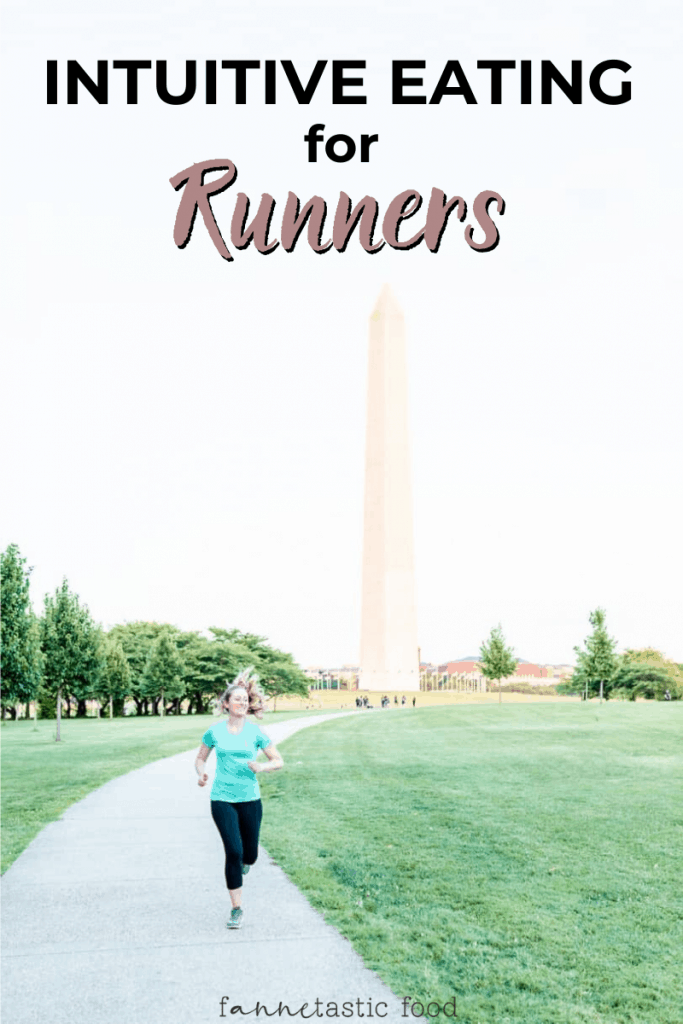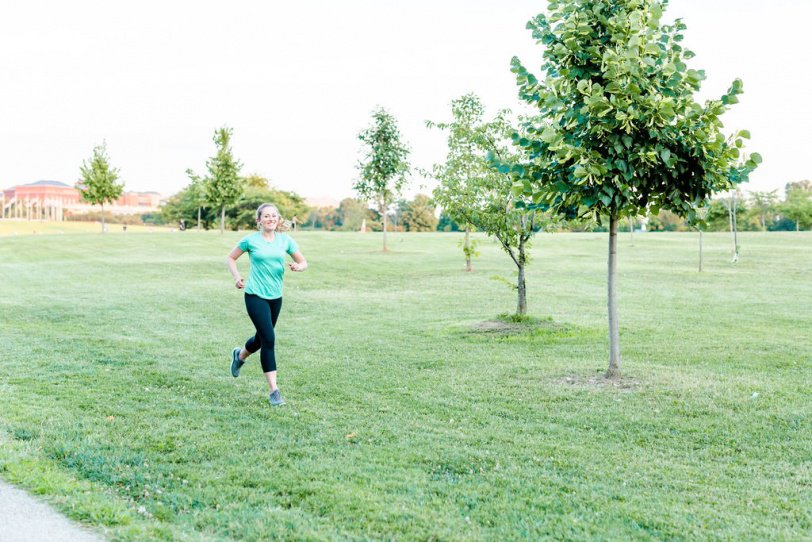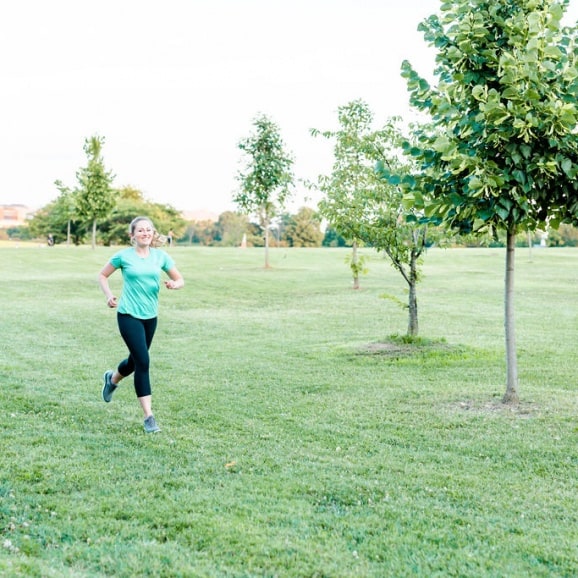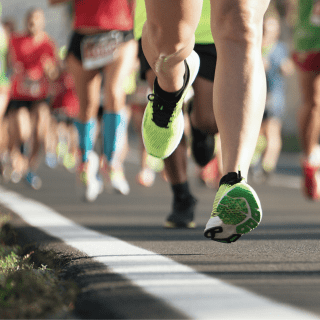As an intuitive eating dietitian who is also a runner, a common question I get is whether or not intuitive eating for runners is possible. The short answer: absolutely!
It can be really easy to get caught up in the diet culture mentality, especially as a runner. But don’t let sports nutrition tips become hard rules rather than guidelines. Is sports nutrition helpful? Of course! But it’s important to not take it too far.
If you’re new to intuitive eating, head over to my post about How to Eat Intuitively to learn more about the basics. You may also find my post Intuitive Eating While Working From Home helpful.
And now, without further ado, here are my tips on how to integrate sports nutrition principles with intuitive eating.

Want to save this post?
Enter your email below and get it sent straight to your inbox. Plus, I'll send you great content every week!
Sports nutrition and intuitive eating – How runners can practice intuitive eating
- Balance sports nutrition and intuitive eating principles
- Listen to your body’s needs
- Respect your body
- Change the way you think and feel about exercise
- Say goodbye to the food police
1. Balance sports nutrition and intuitive eating principles
Intuitive eating can be integrated with sports nutrition as long as you are mindful of when to follow sports nutrition guidelines (like in the middle of a long run/endurance workout) and when to simply listen to your body (the rest of the time).
When running long, it’s easy to forget to eat or to think that you aren’t hungry since your hunger cues are off from the exercise. But you need enough energy to sustain your workouts AND to make sure the body can perform its most basic functions. This is why when you’re running long distances, you really need to stay on top of fueling to avoid crashing!
Part of intuitive eating for runners is being aware that you need to fuel up before or during a run because you know your body will bonk without it, whether or not you are actually feeling hunger.
This is called practical hunger – anticipating your hunger or energy needs – and it’s important because our hunger cues are not reliable when we are in the middle of endurance workouts. I normally won’t feel hungry at all during a long run until my stomach starts growling, and by that point it’s too late – I’m already running on fumes.
The key to figuring out how much fuel to take in during an endurance workout is trial and error, while starting with the basic sports nutrition guidelines. For more specifics here, see my post on How to Fuel a Long Run – it shares exact guidelines for how much fuel to start with, and then you can tweak up or down from there based on how it feels for your body.
Another thing to consider is not just the amount of fuel to take in, but in what form? For example, if you’re on a long run, do you feel best physically sticking with gels or do you need to bring a real food snack (like my Nut Butter Stuffed Salty Dates) that will be more satisfying?
For me, for example, at the half marathon distance I’m fine with just gels, but when I’m running longer than that I tend to get sick of the gels and would rather have fuel that has small amounts of fat and protein to help me from feeling nauseous.
Find what works for you and make adjustments as you go. And keep in mind that fuel needs/preferences may change based on the temperature you are running in, too. Liquid fuel (like my homemade citrus sport drink, pictured below) is an excellent choice for sweaty summer runs, for example!

2. Listen to your body’s needs
Your body will try to tell you what it needs, but it’s up to you to tune in and listen.
Are you feeling lethargic? You might need more carbohydrates. Have you been craving extra protein? Eat some! Does your stomach hurt during your runs? Try a pre-workout snack with a little less fat. Having digestive issues during runs? Try eating less fiber before your runs. Have you noticed that you are super hungry? Exercise burns a lot of calories, so you’ll need to stay on top of the refueling in particular to make sure you aren’t unintentionally setting yourself up for a binge (or for sugar cravings – see my What Causes Sugar Cravings post for more) because you get too hungry.
Being mindful of all of these messages can be tricky, but the more you practice intuitive eating and mindfulness during meals and snacks, the easier it will become. The last thing we want to do as runners is to deprive ourselves of the energy we need to feel great and perform our best!
See my what to eat before and after a long run post for more tips on making sure you are meeting your macronutrient needs around runs while also listening to your body and its cravings.

3. Respect your body
Remember that we all have good and bad training days. Sometimes our bodies are tired and need some extra recovery time, and it’s important to listen! Show yourself compassion and make tweaks to your training schedule/routine when something just isn’t working anymore.
Respecting your body means being more in tune with what it needs nutritionally but also when to push yourself harder vs. take a much-needed rest.
Here are some potential signs of overtraining:
- Trouble sleeping
- Irritability, tiredness, or a change in appetite – these can be caused by hormonal changes triggered by poor recovery
- Changes in or absence of your menstrual cycle
- Decreases in your athletic performance, like feeling sluggish or overly tired during workouts
Overtraining can wreak havoc on your musculoskeletal system, resulting in injuries such as stress fractures, inflamed tendons, ligament strains or tears, and more. Practice intuitive movement by honoring what your body is telling you before it’s too late and you get injured.
4. Change the way you think and feel about exercise
Instead of thinking about exercise as a necessary evil or as a way to burn calories, think about how it nourishes your mind, how energized you feel, and how it benefits your health.
Practice gratitude for your body and its ability to carry you long distances. Our bodies are truly amazing!

5. Say goodbye to the food police
Whether it’s a coach or a fellow runner, people around you will probably judge your food choices at some point or tell you that you need to follow a structured eating plan.
Remember that only you know what is best for your body.
The bottom line on intuitive eating for runners
Practice intuitive eating outside of your runs while making sure you are following gentle nutrition guidelines during your long workouts.
I hope this guide on intuitive eating for runners was helpful! Please let me know your thoughts and any questions you have. I’d be happy to help!
If you are a runner, have you tried intuitive eating?
Here are some of my other posts (that I haven’t already linked to earlier in this post!) on sports nutrition and intuitive eating:
- Top 5 Nutrition Mistakes Made by Runners
- Why You Should Throw Away Your Scale
- Are You Meal Hungry or Snack Hungry?
- What Time Should You Stop Eating?
For more on intuitive eating, I also highly recommend reading the Intuitive Eating book! The 4th edition is being released in June 2020, which will include some new added tips on intuitive eating for kids. You can order it here (affiliate link).
If you’re curious about what it takes to become an RD, check out my post on How to Become a Dietitian (& How I Did It).
I’d also recommend checking out my recent podcast interview all about intuitive eating for running – you can find it on the Cook, Eat, Run podcast.
Running photos credit: Rachel EH Photography






